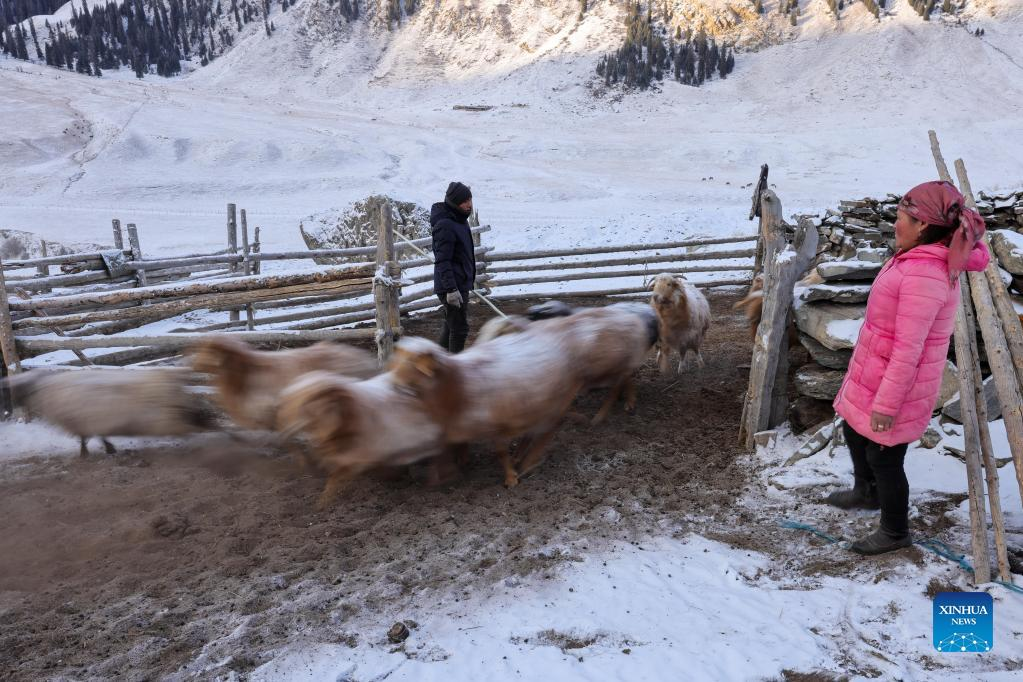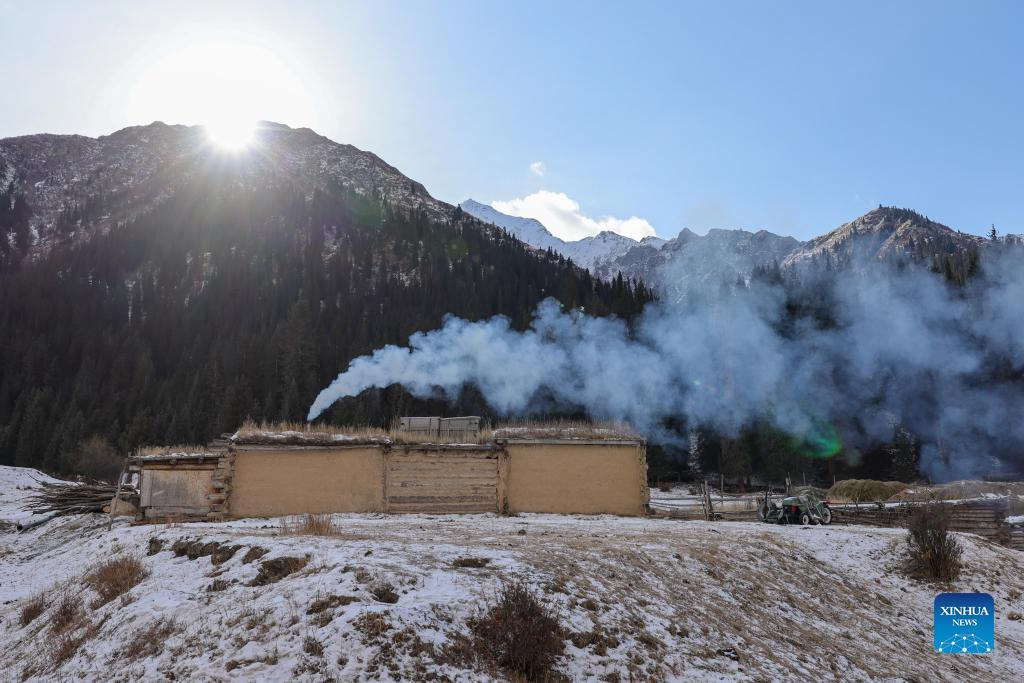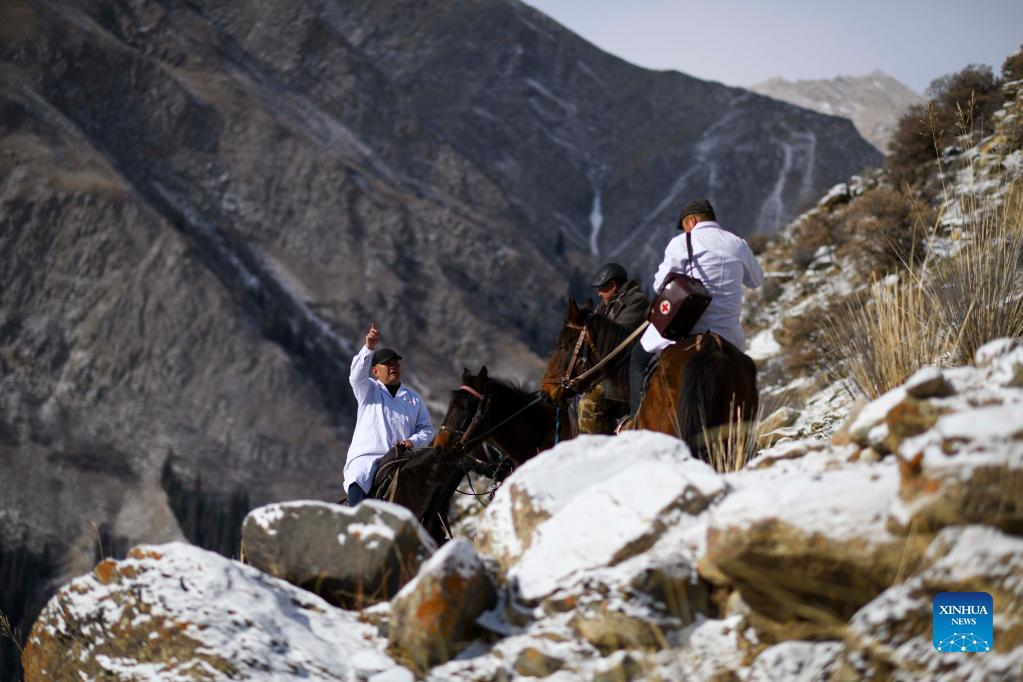Xinjiang's Zhaosu improves living conditions in Akyaz valley for herdsmen

A herdsmen family have breakfast at home in Akyaz Valley in Zhaosu County, Kazak Autonomous Prefecture of Ili, northwest China's Xinjiang Uygur Autonomous Region, Jan. 25, 2022. Akyaz Valley is an important winter pasture for herdsmen in Zhaosu. Every year, herdsmen would migrate along the Akyaz River, driving over 500,000 cattle with them to settle in the valley for the winter. With an average altitude of 3,000 meters, the Akyaz Valley has abundant grass, water and a warmer climate, thanks to the surrounding mountains which block the cold winds. In recent years, while protecting the nomadic tradition, the local government has tried to improve the living conditions in the valley by upgrading the roads, building new communication facilities, installing photovoltaic generators for herdsmen's houses, and constructing animal husbandry hospitals. (Xinhua/Ding Lei)

Veterinarians make a round of visits in Akyaz Valley in Zhaosu County, Kazak Autonomous Prefecture of Ili, northwest China's Xinjiang Uygur Autonomous Region, Jan. 25, 2022. Akyaz Valley is an important winter pasture for herdsmen in Zhaosu. Every year, herdsmen would migrate along the Akyaz River, driving over 500,000 cattle with them to settle in the valley for the winter. With an average altitude of 3,000 meters, the Akyaz Valley has abundant grass, water and a warmer climate, thanks to the surrounding mountains which block the cold winds. In recent years, while protecting the nomadic tradition, the local government has tried to improve the living conditions in the valley by upgrading the roads, building new communication facilities, installing photovoltaic generators for herdsmen's houses, and constructing animal husbandry hospitals. (Xinhua/Ding Lei)

Herdsmen herd sheep in Akyaz Valley in Zhaosu County, Kazak Autonomous Prefecture of Ili, northwest China's Xinjiang Uygur Autonomous Region, Jan. 25, 2022. Akyaz Valley is an important winter pasture for herdsmen in Zhaosu. Every year, herdsmen would migrate along the Akyaz River, driving over 500,000 cattle with them to settle in the valley for the winter. With an average altitude of 3,000 meters, the Akyaz Valley has abundant grass, water and a warmer climate, thanks to the surrounding mountains which block the cold winds. In recent years, while protecting the nomadic tradition, the local government has tried to improve the living conditions in the valley by upgrading the roads, building new communication facilities, installing photovoltaic generators for herdsmen's houses, and constructing animal husbandry hospitals. (Xinhua/Ding Lei)

A herdsman herds sheep in Akyaz Valley in Zhaosu County, Kazak Autonomous Prefecture of Ili, northwest China's Xinjiang Uygur Autonomous Region, Jan. 25, 2022. Akyaz Valley is an important winter pasture for herdsmen in Zhaosu. Every year, herdsmen would migrate along the Akyaz River, driving over 500,000 cattle with them to settle in the valley for the winter. With an average altitude of 3,000 meters, the Akyaz Valley has abundant grass, water and a warmer climate, thanks to the surrounding mountains which block the cold winds. In recent years, while protecting the nomadic tradition, the local government has tried to improve the living conditions in the valley by upgrading the roads, building new communication facilities, installing photovoltaic generators for herdsmen's houses, and constructing animal husbandry hospitals. (Xinhua/Zhao Ge)

Aerial photo taken on Jan. 25, 2022 shows herdsmen herding sheep in Akyaz Valley in Zhaosu County, Kazak Autonomous Prefecture of Ili, northwest China's Xinjiang Uygur Autonomous Region. Akyaz Valley is an important winter pasture for herdsmen in Zhaosu. Every year, herdsmen would migrate along the Akyaz River, driving over 500,000 cattle with them to settle in the valley for the winter. With an average altitude of 3,000 meters, the Akyaz Valley has abundant grass, water and a warmer climate, thanks to the surrounding mountains which block the cold winds. In recent years, while protecting the nomadic tradition, the local government has tried to improve the living conditions in the valley by upgrading the roads, building new communication facilities, installing photovoltaic generators for herdsmen's houses, and constructing animal husbandry hospitals. (Xinhua/Ding Lei)

A herdsmen family have breakfast at home in Akyaz Valley in Zhaosu County, Kazak Autonomous Prefecture of Ili, northwest China's Xinjiang Uygur Autonomous Region, Jan. 25, 2022. Akyaz Valley is an important winter pasture for herdsmen in Zhaosu. Every year, herdsmen would migrate along the Akyaz River, driving over 500,000 cattle with them to settle in the valley for the winter. With an average altitude of 3,000 meters, the Akyaz Valley has abundant grass, water and a warmer climate, thanks to the surrounding mountains which block the cold winds. In recent years, while protecting the nomadic tradition, the local government has tried to improve the living conditions in the valley by upgrading the roads, building new communication facilities, installing photovoltaic generators for herdsmen's houses, and constructing animal husbandry hospitals. (Xinhua/Zhao Ge)

Children play at home in Akyaz Valley in Zhaosu County, Kazak Autonomous Prefecture of Ili, northwest China's Xinjiang Uygur Autonomous Region, Jan. 24, 2022. Akyaz Valley is an important winter pasture for herdsmen in Zhaosu. Every year, herdsmen would migrate along the Akyaz River, driving over 500,000 cattle with them to settle in the valley for the winter. With an average altitude of 3,000 meters, the Akyaz Valley has abundant grass, water and a warmer climate, thanks to the surrounding mountains which block the cold winds. In recent years, while protecting the nomadic tradition, the local government has tried to improve the living conditions in the valley by upgrading the roads, building new communication facilities, installing photovoltaic generators for herdsmen's houses, and constructing animal husbandry hospitals. (Xinhua/Ding Lei)

Aerial photo taken on Jan. 25, 2022 shows the Akyaz Valley in Zhaosu County, Kazak Autonomous Prefecture of Ili, northwest China's Xinjiang Uygur Autonomous Region. Akyaz Valley is an important winter pasture for herdsmen in Zhaosu. Every year, herdsmen would migrate along the Akyaz River, driving over 500,000 cattle with them to settle in the valley for the winter. With an average altitude of 3,000 meters, the Akyaz Valley has abundant grass, water and a warmer climate, thanks to the surrounding mountains which block the cold winds. In recent years, while protecting the nomadic tradition, the local government has tried to improve the living conditions in the valley by upgrading the roads, building new communication facilities, installing photovoltaic generators for herdsmen's houses, and constructing animal husbandry hospitals. (Xinhua/Ding Lei)

Photo taken on Jan. 26, 2022 shows a herdsmen's house in Akyaz Valley in Zhaosu County, Kazak Autonomous Prefecture of Ili, northwest China's Xinjiang Uygur Autonomous Region. Akyaz Valley is an important winter pasture for herdsmen in Zhaosu. Every year, herdsmen would migrate along the Akyaz River, driving over 500,000 cattle with them to settle in the valley for the winter. With an average altitude of 3,000 meters, the Akyaz Valley has abundant grass, water and a warmer climate, thanks to the surrounding mountains which block the cold winds. In recent years, while protecting the nomadic tradition, the local government has tried to improve the living conditions in the valley by upgrading the roads, building new communication facilities, installing photovoltaic generators for herdsmen's houses, and constructing animal husbandry hospitals. (Xinhua/Ding Lei)

Two children play around their house in Akyaz Valley in Zhaosu County, Kazak Autonomous Prefecture of Ili, northwest China's Xinjiang Uygur Autonomous Region, Jan. 26, 2022. Akyaz Valley is an important winter pasture for herdsmen in Zhaosu. Every year, herdsmen would migrate along the Akyaz River, driving over 500,000 cattle with them to settle in the valley for the winter. With an average altitude of 3,000 meters, the Akyaz Valley has abundant grass, water and a warmer climate, thanks to the surrounding mountains which block the cold winds. In recent years, while protecting the nomadic tradition, the local government has tried to improve the living conditions in the valley by upgrading the roads, building new communication facilities, installing photovoltaic generators for herdsmen's houses, and constructing animal husbandry hospitals. (Xinhua/Zhao Ge)

A veterinarian makes a round of visits in Akyaz Valley in Zhaosu County, Kazak Autonomous Prefecture of Ili, northwest China's Xinjiang Uygur Autonomous Region, Jan. 25, 2022. Akyaz Valley is an important winter pasture for herdsmen in Zhaosu. Every year, herdsmen would migrate along the Akyaz River, driving over 500,000 cattle with them to settle in the valley for the winter. With an average altitude of 3,000 meters, the Akyaz Valley has abundant grass, water and a warmer climate, thanks to the surrounding mountains which block the cold winds. In recent years, while protecting the nomadic tradition, the local government has tried to improve the living conditions in the valley by upgrading the roads, building new communication facilities, installing photovoltaic generators for herdsmen's houses, and constructing animal husbandry hospitals. (Xinhua/Zhao Ge)

A veterinarian makes a round of visits in Akyaz Valley in Zhaosu County, Kazak Autonomous Prefecture of Ili, northwest China's Xinjiang Uygur Autonomous Region, Jan. 25, 2022. Akyaz Valley is an important winter pasture for herdsmen in Zhaosu. Every year, herdsmen would migrate along the Akyaz River, driving over 500,000 cattle with them to settle in the valley for the winter. With an average altitude of 3,000 meters, the Akyaz Valley has abundant grass, water and a warmer climate, thanks to the surrounding mountains which block the cold winds. In recent years, while protecting the nomadic tradition, the local government has tried to improve the living conditions in the valley by upgrading the roads, building new communication facilities, installing photovoltaic generators for herdsmen's houses, and constructing animal husbandry hospitals. (Xinhua/Ding Lei)

A woman makes tea at home in Akyaz Valley in Zhaosu County, Kazak Autonomous Prefecture of Ili, northwest China's Xinjiang Uygur Autonomous Region, Jan. 24, 2022. Akyaz Valley is an important winter pasture for herdsmen in Zhaosu. Every year, herdsmen would migrate along the Akyaz River, driving over 500,000 cattle with them to settle in the valley for the winter. With an average altitude of 3,000 meters, the Akyaz Valley has abundant grass, water and a warmer climate, thanks to the surrounding mountains which block the cold winds. In recent years, while protecting the nomadic tradition, the local government has tried to improve the living conditions in the valley by upgrading the roads, building new communication facilities, installing photovoltaic generators for herdsmen's houses, and constructing animal husbandry hospitals. (Xinhua/Ding Lei)

Aerial photo taken on Jan. 26, 2022 shows the Akyaz Valley in Zhaosu County, Kazak Autonomous Prefecture of Ili, northwest China's Xinjiang Uygur Autonomous Region. Akyaz Valley is an important winter pasture for herdsmen in Zhaosu. Every year, herdsmen would migrate along the Akyaz River, driving over 500,000 cattle with them to settle in the valley for the winter. With an average altitude of 3,000 meters, the Akyaz Valley has abundant grass, water and a warmer climate, thanks to the surrounding mountains which block the cold winds. In recent years, while protecting the nomadic tradition, the local government has tried to improve the living conditions in the valley by upgrading the roads, building new communication facilities, installing photovoltaic generators for herdsmen's houses, and constructing animal husbandry hospitals. (Xinhua/Ding Lei)

Photo taken on Jan. 24, 2022 shows sheep in Akyaz Valley in Zhaosu County, Kazak Autonomous Prefecture of Ili, northwest China's Xinjiang Uygur Autonomous Region. Akyaz Valley is an important winter pasture for herdsmen in Zhaosu. Every year, herdsmen would migrate along the Akyaz River, driving over 500,000 cattle with them to settle in the valley for the winter. With an average altitude of 3,000 meters, the Akyaz Valley has abundant grass, water and a warmer climate, thanks to the surrounding mountains which block the cold winds. In recent years, while protecting the nomadic tradition, the local government has tried to improve the living conditions in the valley by upgrading the roads, building new communication facilities, installing photovoltaic generators for herdsmen's houses, and constructing animal husbandry hospitals. (Xinhua/Li Zhihao)

Veterinarians talk to a herdsman during a round of visits in Akyaz Valley in Zhaosu County, Kazak Autonomous Prefecture of Ili, northwest China's Xinjiang Uygur Autonomous Region, Jan. 25, 2022. Akyaz Valley is an important winter pasture for herdsmen in Zhaosu. Every year, herdsmen would migrate along the Akyaz River, driving over 500,000 cattle with them to settle in the valley for the winter. With an average altitude of 3,000 meters, the Akyaz Valley has abundant grass, water and a warmer climate, thanks to the surrounding mountains which block the cold winds. In recent years, while protecting the nomadic tradition, the local government has tried to improve the living conditions in the valley by upgrading the roads, building new communication facilities, installing photovoltaic generators for herdsmen's houses, and constructing animal husbandry hospitals. (Xinhua/Zhao Ge)

A herdsman rides on a horse in Akyaz Valley in Zhaosu County, Kazak Autonomous Prefecture of Ili, northwest China's Xinjiang Uygur Autonomous Region, Jan. 26, 2022. Akyaz Valley is an important winter pasture for herdsmen in Zhaosu. Every year, herdsmen would migrate along the Akyaz River, driving over 500,000 cattle with them to settle in the valley for the winter. With an average altitude of 3,000 meters, the Akyaz Valley has abundant grass, water and a warmer climate, thanks to the surrounding mountains which block the cold winds. In recent years, while protecting the nomadic tradition, the local government has tried to improve the living conditions in the valley by upgrading the roads, building new communication facilities, installing photovoltaic generators for herdsmen's houses, and constructing animal husbandry hospitals. (Xinhua/Li Zhihao)

Aerial photo taken on Jan. 25, 2022 shows herdsmen herding sheep in Akyaz Valley in Zhaosu County, Kazak Autonomous Prefecture of Ili, northwest China's Xinjiang Uygur Autonomous Region. Akyaz Valley is an important winter pasture for herdsmen in Zhaosu. Every year, herdsmen would migrate along the Akyaz River, driving over 500,000 cattle with them to settle in the valley for the winter. With an average altitude of 3,000 meters, the Akyaz Valley has abundant grass, water and a warmer climate, thanks to the surrounding mountains which block the cold winds. In recent years, while protecting the nomadic tradition, the local government has tried to improve the living conditions in the valley by upgrading the roads, building new communication facilities, installing photovoltaic generators for herdsmen's houses, and constructing animal husbandry hospitals. (Xinhua/Ding Lei)
Photos
Related Stories
- Xinjiang to open first plateau airport
- Profile: Xinjiang skier nurturing next generation of sporting excellence
- Xinjiang expands loans to boost high-quality development of agriculture
- Students play snow football game in Xinjiang
- Xinjiang economy expands 7% year-on-year to hit 1.6 trillion yuan; no terrorist attacks in 5 years
Copyright © 2022 People's Daily Online. All Rights Reserved.










